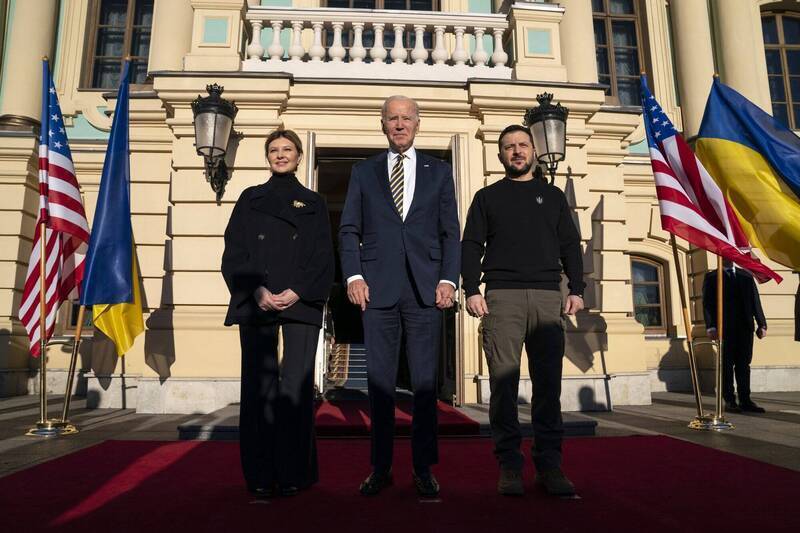Biden (middle) visits Kyiv.
(Associated Press)
[Instant News/Comprehensive Report] During his visit to Kiev on the 20th, US President Biden announced a plan to send weapons worth US$500 million (approximately NT$15.3 billion) to Ukraine, adding that Washington will Provides artillery ammunition, additional howitzers, and more Javelin anti-tank missile systems.
According to a recent analysis of the financial aspects of Kiev aid by the Kiel Institute for The World Economy (IFW), a German think tank, the latest data as of Jan. Of the 37 billion euros (approximately NT$1,200 billion) in aid, the United States has allocated a total of more than 73.1 billion euros (approximately NT$2,370.4 billion) in aid to Ukraine, while the EU has allocated 54.9 billion euros (approximately NT$1 trillion, 780.2 billion yuan), the second and third places were 830 million euros (approximately NT$26.9 billion) in the UK and 615 million euros (approximately NT$20 billion) in Germany.
Please read on...
Overall, humanitarian aid remained relatively stable during the year, while financial and military aid pledges increased.
It is worth noting that the amount of pledged aid dropped sharply in the summer, and aid pledges rebounded and broke records at the end of the year, presumably related to the fact that European countries must allocate budgets to prepare for the coming winter.
The IFW researchers did not include in their calculations Western aid for Ukrainian combat vehicles such as the Leopard 2, which is scheduled to be delivered in March this year.
The reason is that the figures for commitments made by European countries with German tanks are not yet clear enough.
In addition, the value of U.S. military aid to Ukraine exceeds 4.43 billion euros (approximately NT$143.6 billion), which is twice that of the entire EU; It is due to the recent additional commitment of 37 billion euros (approximately NT$1.2 trillion), and the actual payment ratio is 48%.
Europe hesitated to aid Ukraine during the first year of the war, largely because of insufficient government reserves and supplies that could be called upon quickly, and to cope with energy price shocks.
Therefore, in fact, the U.S. aid to Ukraine effectively promotes other allies and EU countries to assist Ukraine.
Since January 2022, Germany alone has announced subsidies of up to 264 billion euros (approximately NT$8.5609 billion) to ease rising energy prices for consumers and businesses, while bilateral aid commitments to Ukraine It is 6.15 billion euros (approximately NT$199.4 billion), which is about the same as the cost of 5.65 billion euros (approximately NT$183.2 billion) for the transportation cost subsidy in the summer of 2022.
Plus 7.2 billion euros (approximately NT$233.4 billion) provided indirectly through the European Union, this only accounts for about 5% of Germany's total energy subsidies.
In addition, the government spent 34.5 billion euros (approximately NT$1.1187 billion) on saving the energy group Uniper, and allocated 100 billion euros (approximately NT$3.2427 billion) for a special military fund to strengthen the German armed forces.
Other EU countries have also committed to massive energy subsidy programs, with the average energy subsidy budget of each country being ten times that of their commitment to Ukraine.
IFW economists also compared Western aid to Ukraine within a year of the war with Western spending in previous wars.
For example, in terms of gross domestic product (GDP), Germany spent more than three times as much aid to Ukraine defending Kuwait during the 1990-91 Gulf War.
After Iraq invaded Kuwait, Germany indirectly provided funds to the United States to help liberate Kuwait.
By comparison, the U.S. has spent nearly 1 percent of GDP on the Gulf War, and Ukraine has so far spent less than 0.4 percent.
From 2001 to 2010, the U.S. spent three times as much each year in Afghanistan than Washington has ever spent defending Ukraine.
Unlike Ukraine, however, the US has also sent ground troops to Afghanistan and the Middle East, which has continued for years at great cost.
The U.S.-Ukraine M2 armored vehicle has arrived in Bremerhaven, Germany, and will transfer to Ukraine by railway.
(Picture taken from @UKR_Report Twitter)
